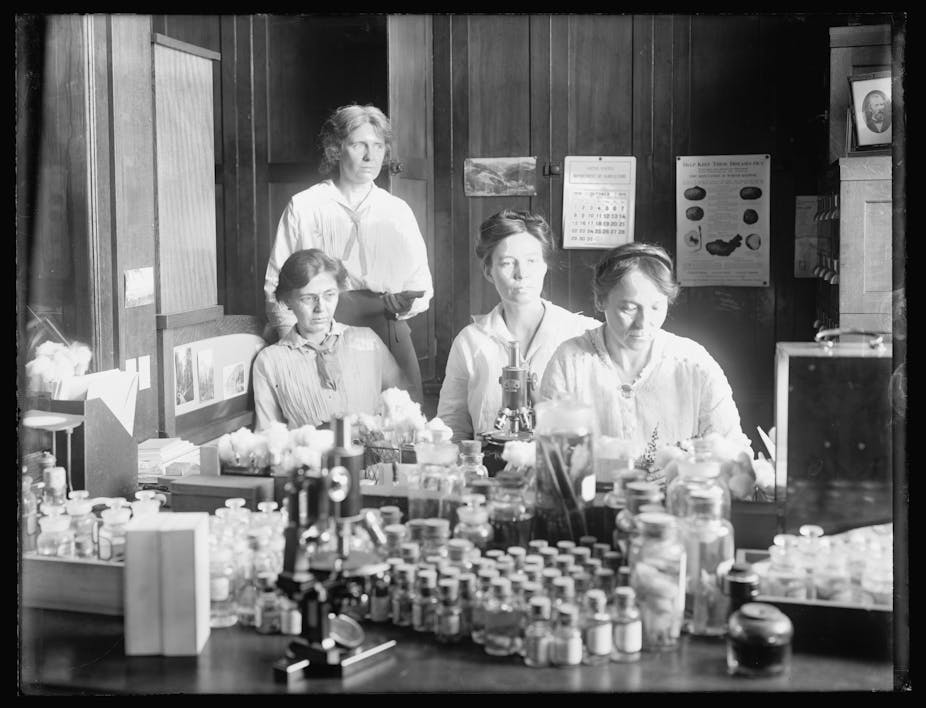There’s a lot more good news for women in science than you might expect. Research shows that the landscape for women working in scientific disciplines – including maths, engineering and technology – has improved dramatically over the past 50 years.
Gender representation and sexism are taken far more seriously than used to be the case. Behaviour that may once have been swept under the carpet is now openly and roundly condemned.
A Nobel Prize-winning scientist, Sir Tim Hunt, resigned in 2015 from University College London in the wake of a sexism row. Also in 2015, renowned astronomer Geoff Marcy quit the faculty of the University of California, Berkeley, after being found guilty of sexually harassing women students. And the world’s most important science journals have dedicated entire issues to gender and equality concerns.
These sea changes have been largely driven by three factors: the general advancement of women in society; the implementation in many countries of gender-sensitive policies designed to attract more women to the sciences; and, as illustrated above, a growing awareness in the global scientific community about the realities of gender bias.
But, as the world celebrates International Women’s Day on March 8, it’s worth exploring what still needs to be done – and whether science can ever be a truly equitable space while society more broadly is not.
No gender parity yet
The United Nations’ 2016 theme for International Women’s Day is:
Planet 50-50 by 2030: Step it up for gender equality.
This is linked to the UN’s Agenda 2030 and its Sustainable Development Goals. Scientists still have a long way to go before hitting the 50/50 mark for women’s representation.
The problem starts from student years: women are significantly more likely to drop out of science careers at doctoral level than their male counterparts.
Beyond university, women scientists remain in the minority. The most recent UNESCO Science Report shows that only about 30% of the world’s researchers in science, technology, engineering and maths are women.
Their under-representation is even more pronounced when one considers rank – women are far less likely to become full professors in these fields, to become members of the prestigious Academy of Science or to sit on scientific journals’ editorial boards.
So what is holding women back in university classes and research labs? A number of studies have suggested the following factors:
gender bias at graduate level;
unconscious gender bias in applying performance and promotion evaluation criteria;
a disparity in funding awards – men get more funding to conduct research that will go on to boost their professional reputation;
a lack of institutional support for women; and
more personal and cultural aspects such as the idea that women must put their families first and take on more domestic responsibilities than their male colleagues.
So: we know that gender bias in science is real. We know that it must be addressed. But are scientists focusing too much on trying to patch up what is actually broader societal damage? Scientific research and endeavour doesn’t exist in a vacuum: it is being conducted in a world full of gender bias.
Women must feel free to take risks
As a student, I was extremely shy and barely ever asked questions during lectures.
I see the same thing happening now that I am a lecturer. Female students don’t ask a lot of questions. Nor do they take risks by challenging my assertions or questioning me closely about something they don’t understand. This is what happens when you’ve been raised in a patriarchal society – and most are – that discourages women from asking questions or standing out in any way.
It has been reported that girls’ lack of self-confidence directly impacts their performance in school maths and science.
This doesn’t surprise me. After all, science is based on engaging with a process of trial and error. Self-confidence gives a person the freedom to allow themselves to fail, take risks and not fear getting things wrong.
Those risks are bound to increase as one climbs the ladder to become a principal investigator or group leader on a research project. Leadership and decision-making are based on both competence and self-confidence.
Women certainly don’t lack the former. Employers, institutions, lab managers and colleagues all have a role to play in making work a safe space for women scientists to take risks without feeling judged.
A far bigger battle
This is the heart of the matter. As long as scientists focus only on individual episodes of gender bias in their fields – or in any other facet of human life – not much will really change.
Science exists in a social and cultural context that prioritises men over women. While women are still undermined, discriminated against, denied access to education and paid less than men, there cannot be true equality in science.

